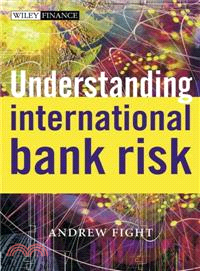Understanding International Bank Risk
商品資訊
ISBN13:9780470847688
出版社:John Wiley & Sons Inc
作者:Fight
出版日:2003/12/22
裝訂/頁數:精裝/248頁
定價
:NT$ 5130 元優惠價
:90 折 4617 元
若需訂購本書,請電洽客服 02-25006600[分機130、131]。
商品簡介
作者簡介
目次
相關商品
商品簡介
In an era of globalisation, syndicated lending and consolidation within the banking industry, virtually all industries will have international dealings, whether directly or indirectly, and will therefore be exposed to consequential risks. An understanding of international risk, from that of bank of country failure to the idiosyncrasies of different regulatory frameworks, is essential for the modern banker. This book gives the reader a thorough understanding of how to calculate, analyse and manage such risks.
作者簡介
ANDREW FIGHT provides financial training and consulting services in the areas of Financial Analysis, Commercial, Syndicated, and Project Finance Lending, Asset Liability Management, Credit Risk Management, and Problem Loan Management. He has over 15 years of experience in international banking and financial analysis gained in Paris and London with Chase Manhattan Bank, IBCA Rating Agency, Euromoney Training, and the French Banker's Training Institute. He is a financial trainer and consultant to several banks, central banks, and IT companies, and a successful author, having written over 15 books on financial analysis, banking risk analysis, credit risk management, credit rating agencies, and information technology in financial services. He divides his time between London, where he works, and his home in the South of France.
目次
Foreword.
About the Author.
1 The Banking Background.
1.1 Different types of banks and their risk profile.
1.1.1 Bank failure and the financial services community.
1.1.2 What do banks do? How do they earn their money?
1.1.3 Different types of banks and their revenue structures.
1.1.4 Commercial banks.
1.1.5 Investment banks.
1.1.6 Risk profile of investment banks.
1.1.7 Broking is a competitive business.
1.1.8 Derivatives trading and AAA subsidiaries.
1.1.9 The regulation of investment banks.
1.1.10 “Analyst of the year” awards.
1.2 Primary causes of bank failure.
1.2.1 Types of failures.
1.2.2 Causes of losses.
1.2.3 Warning signals in predicting bank failure.
1.2.4 Rescuing the bank!
1.2.5 Credit rating agencies.
1.3 Bank failures – the four aces.
1.3.1 Bank of Credit and Commerce International.
1.3.2 Continental Illinois.
1.3.3 Crédit Lyonnais.
1.3.4 Rumasa.
1.4 The macroeconomic environment.
1.4.1 Banking system and industry risks.
1.4.2 Economic environment.
1.4.3 Industry competition and its impact on banks.
1.4.4 Technology.
2 The Rating Framework.
2.1 What is a rating?
2.2 The development of ratings.
2.3 Background to rating agencies.
2.3.1 Inconsistent initial foundations.
2.3.2 Secretive deliberations.
2.3.3 Main source of revenues.
2.3.4 Generating value.
2.3.5 Growth and the future.
2.4 The rating analytical framework.
2.4.1 CAMEL, CAMEL B-COM, and CAMELOT.
2.4.2 Capital.
2.4.3 Asset quality.
2.4.4 Management.
2.4.5 Earnings.
2.4.6 Liquidity (liability management).
2.5 How the rating agencies analyse bank risk.
2.5.1 What is a rating?
2.5.2 Rating scale comparisons.
2.5.3 Standard & Poor’s ratings.
2.5.4 Moody’s ratings.
2.5.5 Fitch performance and legal ratings.
3 The Regulatory Framework.
3.1 Banking system: structure, governing law, and regulations.
3.1.1 Banking supervision.
3.2 Core principles for effective banking supervision.
3.2.1 Core principles for effective banking supervision.
3.2.2 Basel committee publications No. 30 (September 1997) on banking principles.
3.3 Risk management.
3.3.1 Generally accepted risk principles.
3.3.2 Derivatives and market risk.
3.3.3 Managing bank limits.
3.3.4 Generally accepted risk principles risk map.
3.4 Basle Capital Adequacy and international convergence.
3.4.1 Background to the Basle Capital Adequacy regime.
3.4.2 Pressures for change.
3.4.3 The BIS paper: the response of the central banks.
3.4.4 Foreign exchange and interest rate related exposure.
3.4.5 Implementation.
3.4.6 Impact of the BIS proposals.
4 The Analytical Framework.
4.1 Introduction.
4.1.1 The specific nature of bank financial analysis.
4.1.2 Sources of information on banks.
4.1.3 Other sources of information.
4.2 Financial criteria – the key factors.
4.2.1 Financial statement analysis.
4.2.2 Spreadsheet analysis.
4.3 Understanding the bank’s balance sheet.
4.3.1 Overview.
4.3.2 Balance sheet.
4.3.3 Assets.
4.3.4 Liabilities.
4.3.5 Contingent liabilities.
4.3.6 Income statement.
4.3.7 Financial analysis of investment banks.
4.3.8 Risk profile of investment banks.
5 Bankscope and Comparative Techniques.
5.1 Bankscope spreadsheet analysis.
5.2 Bankscope ratios and ratio analysis.
5.2.1 Lines of the Bankscope global format.
5.2.2 Financial ratio analysis.
5.2.3 The Bankscope ratios.
5.3 Bank peer group analysis.
5.3.1 Analytical techniques.
5.4 Problems with intercountry comparisons.
5.4.1 Local vs international accounting standards.
5.4.2 Inflation accounting.
5.4.3 Creative accounting and ratio manipulation.
6 Country and Political Risk.
6.1 Country risk.
6.1.1 Introduction to country risk.
6.1.2 Definition of country risk.
6.1.3 Types of countries.
6.1.4 Country risk assessment.
6.2 Political risk.
6.2.1 Introduction to political risk.
6.2.2 Time dimension.
6.2.3 Political risk analysis methodologies.
6.2.4 World Bank list of countries.
6.3 Typical sovereign ratings process.
6.3.1 Introduction.
6.3.2 Political risk.
6.3.3 Economic risk.
6.3.4 S&P’s sovereign ratings profiles.
6.3.5 Behind the sovereign ratings exercise.
7 The World of E-finance.
7.1 A quick definition of e-finance.
7.2 CRM – Customer Relationship Management.
7.3 STP/CLS.
7.3.1 STP – Straight Through Processing.
7.3.2 CLS – Continuous Linked Settlement.
7.3.3 Establishment of Continuous Linked Settlement services.
7.4 SWIFT.
7.4.1 Background.
7.5 Electronic funds transfer.
7.6 Online banking.
7.7 Day trading.
7.8 Smart cards.
7.9 Evolution of e-finance.
7.10 Origin of e-finance and internet commerce.
7.10.1 Rise Of e-finance and electronic trading.
8 Conclusion.
Glossary.
Suggested Readings.
Appendix I.
Appendix II.
Appendix III.
Index.
About the Author.
1 The Banking Background.
1.1 Different types of banks and their risk profile.
1.1.1 Bank failure and the financial services community.
1.1.2 What do banks do? How do they earn their money?
1.1.3 Different types of banks and their revenue structures.
1.1.4 Commercial banks.
1.1.5 Investment banks.
1.1.6 Risk profile of investment banks.
1.1.7 Broking is a competitive business.
1.1.8 Derivatives trading and AAA subsidiaries.
1.1.9 The regulation of investment banks.
1.1.10 “Analyst of the year” awards.
1.2 Primary causes of bank failure.
1.2.1 Types of failures.
1.2.2 Causes of losses.
1.2.3 Warning signals in predicting bank failure.
1.2.4 Rescuing the bank!
1.2.5 Credit rating agencies.
1.3 Bank failures – the four aces.
1.3.1 Bank of Credit and Commerce International.
1.3.2 Continental Illinois.
1.3.3 Crédit Lyonnais.
1.3.4 Rumasa.
1.4 The macroeconomic environment.
1.4.1 Banking system and industry risks.
1.4.2 Economic environment.
1.4.3 Industry competition and its impact on banks.
1.4.4 Technology.
2 The Rating Framework.
2.1 What is a rating?
2.2 The development of ratings.
2.3 Background to rating agencies.
2.3.1 Inconsistent initial foundations.
2.3.2 Secretive deliberations.
2.3.3 Main source of revenues.
2.3.4 Generating value.
2.3.5 Growth and the future.
2.4 The rating analytical framework.
2.4.1 CAMEL, CAMEL B-COM, and CAMELOT.
2.4.2 Capital.
2.4.3 Asset quality.
2.4.4 Management.
2.4.5 Earnings.
2.4.6 Liquidity (liability management).
2.5 How the rating agencies analyse bank risk.
2.5.1 What is a rating?
2.5.2 Rating scale comparisons.
2.5.3 Standard & Poor’s ratings.
2.5.4 Moody’s ratings.
2.5.5 Fitch performance and legal ratings.
3 The Regulatory Framework.
3.1 Banking system: structure, governing law, and regulations.
3.1.1 Banking supervision.
3.2 Core principles for effective banking supervision.
3.2.1 Core principles for effective banking supervision.
3.2.2 Basel committee publications No. 30 (September 1997) on banking principles.
3.3 Risk management.
3.3.1 Generally accepted risk principles.
3.3.2 Derivatives and market risk.
3.3.3 Managing bank limits.
3.3.4 Generally accepted risk principles risk map.
3.4 Basle Capital Adequacy and international convergence.
3.4.1 Background to the Basle Capital Adequacy regime.
3.4.2 Pressures for change.
3.4.3 The BIS paper: the response of the central banks.
3.4.4 Foreign exchange and interest rate related exposure.
3.4.5 Implementation.
3.4.6 Impact of the BIS proposals.
4 The Analytical Framework.
4.1 Introduction.
4.1.1 The specific nature of bank financial analysis.
4.1.2 Sources of information on banks.
4.1.3 Other sources of information.
4.2 Financial criteria – the key factors.
4.2.1 Financial statement analysis.
4.2.2 Spreadsheet analysis.
4.3 Understanding the bank’s balance sheet.
4.3.1 Overview.
4.3.2 Balance sheet.
4.3.3 Assets.
4.3.4 Liabilities.
4.3.5 Contingent liabilities.
4.3.6 Income statement.
4.3.7 Financial analysis of investment banks.
4.3.8 Risk profile of investment banks.
5 Bankscope and Comparative Techniques.
5.1 Bankscope spreadsheet analysis.
5.2 Bankscope ratios and ratio analysis.
5.2.1 Lines of the Bankscope global format.
5.2.2 Financial ratio analysis.
5.2.3 The Bankscope ratios.
5.3 Bank peer group analysis.
5.3.1 Analytical techniques.
5.4 Problems with intercountry comparisons.
5.4.1 Local vs international accounting standards.
5.4.2 Inflation accounting.
5.4.3 Creative accounting and ratio manipulation.
6 Country and Political Risk.
6.1 Country risk.
6.1.1 Introduction to country risk.
6.1.2 Definition of country risk.
6.1.3 Types of countries.
6.1.4 Country risk assessment.
6.2 Political risk.
6.2.1 Introduction to political risk.
6.2.2 Time dimension.
6.2.3 Political risk analysis methodologies.
6.2.4 World Bank list of countries.
6.3 Typical sovereign ratings process.
6.3.1 Introduction.
6.3.2 Political risk.
6.3.3 Economic risk.
6.3.4 S&P’s sovereign ratings profiles.
6.3.5 Behind the sovereign ratings exercise.
7 The World of E-finance.
7.1 A quick definition of e-finance.
7.2 CRM – Customer Relationship Management.
7.3 STP/CLS.
7.3.1 STP – Straight Through Processing.
7.3.2 CLS – Continuous Linked Settlement.
7.3.3 Establishment of Continuous Linked Settlement services.
7.4 SWIFT.
7.4.1 Background.
7.5 Electronic funds transfer.
7.6 Online banking.
7.7 Day trading.
7.8 Smart cards.
7.9 Evolution of e-finance.
7.10 Origin of e-finance and internet commerce.
7.10.1 Rise Of e-finance and electronic trading.
8 Conclusion.
Glossary.
Suggested Readings.
Appendix I.
Appendix II.
Appendix III.
Index.
主題書展
更多
主題書展
更多書展今日66折
您曾經瀏覽過的商品
購物須知
外文書商品之書封,為出版社提供之樣本。實際出貨商品,以出版社所提供之現有版本為主。部份書籍,因出版社供應狀況特殊,匯率將依實際狀況做調整。
無庫存之商品,在您完成訂單程序之後,將以空運的方式為你下單調貨。為了縮短等待的時間,建議您將外文書與其他商品分開下單,以獲得最快的取貨速度,平均調貨時間為1~2個月。
為了保護您的權益,「三民網路書店」提供會員七日商品鑑賞期(收到商品為起始日)。
若要辦理退貨,請在商品鑑賞期內寄回,且商品必須是全新狀態與完整包裝(商品、附件、發票、隨貨贈品等)否則恕不接受退貨。
























